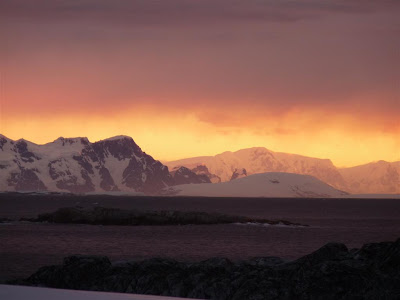0
Yesterday I boated by a curious crescent of metal sticking out of the water, about 30 feet long, and I thought I would tell you a story about it. Its a story that remembers an event 20 years ago today, in 1989, not a great year for the coastal environment.
I start by telling you the usual things. The Bahia Paraiso was a shiny and impressive ship owned by the Argentine Navy and used to supply their Antarctic bases. At nearly 500 feet long, she carried a crew of several hundred souls and 2 helicopters. In January 1989 she was carrying 250,000 gallons of fuel oil bound for the stations as well as 150 paying tourists. After visiting Palmer station that morning, she was on the approach out through an area marked "Dangerous ledges and pinnacles". Apparently though, that marking didn't appear on the Argentine charts and the ship's captain ignored advice that he take another route. Only a mile from station, one of those rock pinnacles near beautiful DeLaca Island rose up and bit the ship. She immediately lost power. As the story goes, Ted DaLaca, ironically the polar scientist for whom the beautiful island had been named, was watching from the galley windows when he saw the boat grind to a stop and begin to list. Leaning back towards the cook he hollered "we'll have another 300 for lunch".

 Thus began the rescue operation. Using our few zodiacs, Palmer folks cycled to and from the shipwreck, pulling liferafts of people to station. Luckily for all involved the weather stayed calm, averting injuries or fatalities. An emergency bulletin to ships in the area had the tourists evacuated quickly, leaving the station only awash in the 300 Argentine sailors, camped out in tents and and in life rafts pulled ashore.
Thus began the rescue operation. Using our few zodiacs, Palmer folks cycled to and from the shipwreck, pulling liferafts of people to station. Luckily for all involved the weather stayed calm, averting injuries or fatalities. An emergency bulletin to ships in the area had the tourists evacuated quickly, leaving the station only awash in the 300 Argentine sailors, camped out in tents and and in life rafts pulled ashore.
The people saved, thought turned immediately to the oil spill in progress. A oil skimmer boat was flown in, arriving 9 days after the shipwreck, but was largely unable to recover any oil. A second effort, 2 years later was significantly more successful.
The short term devastation was pronounced. Compared to the crude oil that would spill out of the Exxon Valdez just two months later, the arctic diesel that spilled out was much more toxic but evaporated much quicker without leaving a tar along the shore. Impact to the bird life in the area differed according to species. The spill occurred in the middle of their breeding season and immediately resulted in huge die-off of the krill that form the base of their diet. Gastropods were also hit hard with 50% observed mortality within weeks. Limpets are the mainstay of Kelp Gulls which need them to raise chicks successfully. Limpets and other gastropods in the area grow very slowly, so this single event may have decreased the amount of some food items available over a long period of time.
Although virtually all penguins were exposed to the oil, fuel adult birds seem to have been killed. The chicks were hit worse with an observed mortality of 16% to Adelie penguins and virtually 100% to Skua and Cormorants.
In the years since the wreck, the populations of penguins and many other birds seems to have recovered. Cormorants and Gulls remain tremendously affected however. In the case of the Cormorants, the population of nesting pairs declined 75% in the years immediately following the wreck and have never recovered.
And despite the recovery efforts, a small sheen of oil is still present today, coating the surface above part of the wreck. Despite a number of smaller spills, the Bahia is considered the worst environmental disaster to be visited on Antarctica.
So where in is the yang part ?

 Its in what is growing beneath the surface. The structure of the ship creates lots of surface area that ice can’t form on. As a result, algae and animals species occur in great abundance on the wreck that only appear at greater depth, or barely at all, elsewhere in the area.
Its in what is growing beneath the surface. The structure of the ship creates lots of surface area that ice can’t form on. As a result, algae and animals species occur in great abundance on the wreck that only appear at greater depth, or barely at all, elsewhere in the area.
So the wreck has become a valuable collection spot and is regularly visited by scientists and film crews. However, I think we’d all rather get the intact ecosystem back.




 The change has been surprising fast. In January we were enjoying 22 hours of daylight and warm temperatures above freezing.
The change has been surprising fast. In January we were enjoying 22 hours of daylight and warm temperatures above freezing.



































